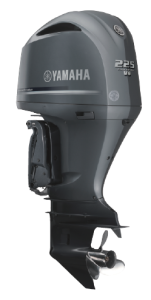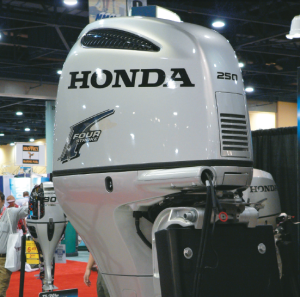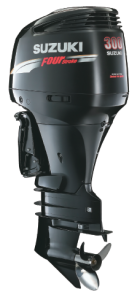WE LOOK AT WHAT THE OUTBOARD MANUFACTURERS ARE OFFERING IN THE LARGER HORSEPOWER ENGINES AND WHAT THEY ARE DOING TO MAKE THEM MORE EFFICIENT.
Outboard technology has probably moved ahead faster than any other power system, with the demanding requirements for ‘green engines’ resulting in more efficient outboards.
It wasn’t until the mid 1990s that we started to see some big changes in outboard technology. Four-strokes direct fuel injection two-strokes paved the way towards a whole new era and today technology has made massive leaps forward that have unquestionably brought outboards right to the forefront as an alternative power option.
It wasn’t so many years ago that we were happy to bolt carburetted engines onto our transoms and the fact they used copious amounts of fuel, smoked when idling and had inherent corrosion problems was of concern but accepted. That was the nature of the beast!
Well, not so anymore, with the major outboard manufacturers all hell bent on making their products lighter, more efficient and greener than their competitors. The result has been a deluge of new engines with new technology that a few years ago wouldn’t have even been thought of.
While the dominance has certainly been on the larger horsepower engines, the mid range and portables have not been forgotten. Now we can buy 2hp four-strokes that are so light the kids can carry them and most manufacturers now offer a full range of four-strokes from single cylinder to six cylinder.
There are still two distinct paths engine builders are on, direct injection two-stroke or fourstroke.
Direct Injection
The benefits of direct injection are very pronounced in two-stroke engines, because it eliminates much of the pollution they cause. In conventional two-strokes, which are pistonported, the exhaust and intake ports are both open at the same time, at the bottom of the piston stroke. A large portion of the fuel/air mixture entering the cylinder from the crankcase through the intake ports goes directly out, unburned, through the exhaust port. With direct injection, only air comes from the crankcase, and fuel is not injected until the piston rises and all ports are closed.
Compared to the two-strokes of old, the new direct injection two-strokes and multipoint sequential EFI four-strokes don’t smoke and don’t foul up injectors or plugs.
Two types of direct injection are used in twostrokes: low-pressure air-assisted, and highpressure. The former, used by Mercury in its OptiMax range, injects a jet of compressed air into the combustion chamber, hitting the plume of atomised fuel from the injector nozzle, further atomising the fuel.
In the early 1990s, Ficht GmbH of Kirchseeon, Germany developed a high-pressure direct injector for use with two-stroke engines. Outboard Marine Corporation (OMC) licensed the technology in 1995 and introduced it on a production outboard engine in 1996. Beset by extensive warranty claims for its Ficht outboards and prior financial problems, OMC declared bankruptcy in December 2000 and the engine manufacturing portion and brands Evinrude and Johnson, including the Ficht technology, were purchased by BRP in 2001. BRP dropped the Johnson brand and today markets all its outboards as Evinrudes. BRP introduced the Evinrude E-TEC system, an improvement to the Ficht fuel injection, in 2003 and it is still in use today. The E-TEC injector is unique in generating all of the necessary injection pressure within itself, and the supply pump and fuel lines run at a little over 240kPa (about the same as the pressure in car tyres).
Yamaha’s high-pressure direct injection system differs from the E-TEC system in that it uses a separate, belt driven, high-pressure mechanical fuel pump to generate the pressure necessary for direct injection. This is similar to most current four-stroke automotive designs.
Four-Stroke
The Japanese outboard manufacturers Honda and Suzuki have put their future in four-strokes and unlike their competitors don’t offer any direct injection two-stroke engines in their line-ups.
The four strokes refer to intake, compression, combustion (power), and exhaust strokes that occur during two crankshaft rotations per working cycle of the gasoline engine and diesel engine.
On the intake or induction stroke of the piston, the piston descends from the top of the cylinder to the bottom of the cylinder, reducing the pressure inside the cylinder. A mixture of fuel and air is forced by atmospheric pressure (or greater pressure in the case of turbocharging and/or supercharging) into the cylinder through the intake port. The intake valves then close.
With both intake and exhaust valves closed, the piston returns to the top of the cylinder, compressing the fuel-air mixture. This is known as the compression stroke.
While the piston is close to top dead centre, the compressed air-fuel mixture is ignited, usually by a spark plug or by the heat and pressure of compression (for a diesel cycle or compression ignition engine). The resulting massive pressure from the combustion of the compressed fuel-air mixture drives the piston back down toward bottom dead centre with tremendous force.
During the exhaust stroke, the piston once again returns to top dead centre while the exhaust valve is open. This action almost completely evacuates the products of combustion from the cylinder by pushing the spent fuel-air mixture past the open exhaust valves.
In the last few years, huge advances have been made in four-stroke technology especially in weight reduction and fuel efficiency.
Yamaha’s Lightweight technologies

Yamaha recently released a new engine platform it calls the Offshore Series.
Yamaha has applied innovative uses of materials and processes and taken a completely fresh approach to designing this new generation of outboards, which includes new Yamaha F225F, F250D and F300B models and a new mid-range Yamaha F70A. The reduction in weight has been achieved through the use of new materials, and by a power head-engineering approach that seeks to gain the highest power output consistent with excellent long-term reliability.
By using a thermally-applied plasma fusion process on the cylinder walls, Yamaha’s new line of V6 Offshore outboards have no conventional steel cylinder sleeves, yet the cylinder walls are 60% harder than steel.
That means that essentially the same block can have larger cylinder bores for increased displacement, resulting in more power and torque, without increasing outer cylinder dimensions. It also results in significantly lighter weight, better cooling, and “micro-textured” cylinder walls that help decrease friction loss, further increasing performance and enhancing reliability.
New Flagship for Honda
Honda has taken some considerable time in adding a 250hp engine to its stable. The new BF250, due to be available later this year, is based on a new, larger-displacement 3.6L engine, designed to deliver the optimum balance of performance and fuel efficiency, through exclusive Honda technologies including BLAST – air/fuel ratio linked ignition timing control technology; VTEC – variable valve timing and electronic control; and ECOmo – Honda’s lean burn control system. All of these technologies are currently used in the current Honda V6 engine range.

The new engine will also be NMEA 2000 compliant, allowing engine-to-electronics data communication to deliver engine management and performance data to compatible marine electronics displays.
More Efficient Suzuki

Late in 2010 Suzuki gave its 4.0L DF300 a makeover, with the addition of its Lean Burn Control technology as well as a new Oxygen Feedback Control System, which have resulted in a significant improvement in fuel economy as well as more environmentally friendly operation.
Reports indicate the DF300 to be 15% more economical overall than the original DF300, without sacrificing any of the power.
Suzuki’s Lean Burn Control System predicts fuel needs according to operating conditions, allowing the engine to run on a more efficient mixture through the use of a lean air-fuel ratio. This system delivers its benefits over a wide operating range, providing significant improvements in fuel economy from low-speed operation into the cruising range.
By combining this unique Lean Burn Control System with the Suzuki Precision Control, Suzuki’s electronic throttle system, which is already a key feature of the standard DF300, enables infinite electronic control of the fuel flow and air flow, increasing the limit of the controllable revolution range. This improves the fuel economy across a much wider range of engine speeds.
The Oxygen Feedback Control System, which is the first to be employed in a Suzuki outboard, enables the emissions to be more stable and cleaner than prior systems. In another first, the new generation DF300 also incorporates a new fuel filter that detects if there is any water in the fuel and warns the operator.
Mercury packs a punch
Mercury Marine has all the bases covered with four-stroke and two-stroke engines, packaged with direct injection, EFI and even supercharged.
The Verado four-stroke supercharged engines have been around since 2004 but in recent times Mercury has added to the range. Earlier Verados were all based on an in-line 2.6-litre six cylinder block, which at the lower end of the horsepower range proved somewhat overweight on some boats.
With the addition of the 135hp, 150hp, 175hp and 200hp L4 Verados, all based on a 1.7 litre four cylinder powerhead, Mercury increased the Verado’s suitability, especially on smaller boats. All engines are still supercharged.
Verado is the world’s first production outboard to feature a supercharger. Its impressive torque figures and acceleration numbers are the result of an exclusive supercharged induction system with intercooling and electronic boost-pressure control.
Verado’s supercharger, co-developed by Mercury and IHI Turbo America, significantly boosts power output by forcing a larger volume of air into the combustion chambers than what could be delivered by a naturally aspirated system. The supercharger enables Verado to create outstanding horsepower from a smaller-displacement cylinder block.
Traditionally, a minimum of 3.0 litres has been required for the typical mass-produced 250-hp outboard engine. Mercury’s strategy of more horsepower from less displacement clearly differentiates Verado from standard V-block four-stroke marine engines. Verado’s valve train features four valves per cylinder, driven by double overhead camshafts.
Despite having the smallest displacement of all the engines of 150hp and above, the engines are built tough. Verado’s unique long bolt engine design provides excellent durability by keeping the power head in a constant state of compression. The extra-long bolts that pass through the bedplate, block, and cylinder, are supported by rubber dampening elements to minimise the effects of engine vibration.
The Verado charge air cooler teams with the supercharger to deliver plenty of instant power and acceleration by cooling the compressed air before it enters the combustion chambers. In addition, the Verado injection-moulded intake manifold increases torque and power by delivering higher levels of airflow.
Recently introduced is the Verado 250 Pro, the newest addition to the expanding Verado line-up.
Evinrude Perfecting Direct Injection
Although it has not released anything significantly new in its larger engine packages recently, BRP has continued to perfect its E-TEC system, now used on all its engines, right down to the new 15hp model.
The fuel injectors are driven by the common Lorentz coil, the permanent magnet and coil winding that is the heart and soul of a loudspeaker. A Lorentz coil is renowned for the way it can push and pull very quickly and for the way its strength and the direction of its pulse can be widely varied. That makes it ideal for spraying fuel into the combustion chamber at up to 4.15MPa (just over 40 atmospheres), and the injector is fast enough to allow engine speeds of up to 10,000rpm. This precise control over the plume of fuel means engineers can make the engine do just about anything they demand of it, from one hp at idle all the way to maximum output at wide open throttle.
At low rpm, small droplets are sprayed directly over the spark plug and are ignited as a stratified charge. That lends the engine a smooth, clean idle, an essential operating characteristic when trolling. At higher rpm and horsepower, larger droplets cool the top of the piston. That builds maximum horsepower without wasting fuel. Beyond the theoretical, the E-TEC method of direct injection has also proven itself on the water. Throttle response is razor sharp. Naturally, these engines are also clean burning. With the E-TEC outboard motor running, there is no smoke, not at idle, or at any rpm on the way up to WOT. The reason for the clean burn is because no oil is mixed with the gas. During its design, engineers targeted oil delivery to critical components, such as crankshaft roller bearings and piston skirts, so the engine gets a precise dosage of lubricant, exactly where it’s needed.
A magneto is direct-mounted on the crankshaft and also anchored to the block, thus completely eliminating drive belts. Also, quite amazingly, all of the electrical energy necessary to run an E-TEC’s engine management system, including the spark plugs, is supplied from the magneto. All the battery does is supply the energy to turn the starter motor. So if you can start an E-TEC by hand, it’ll run, even without a battery!




